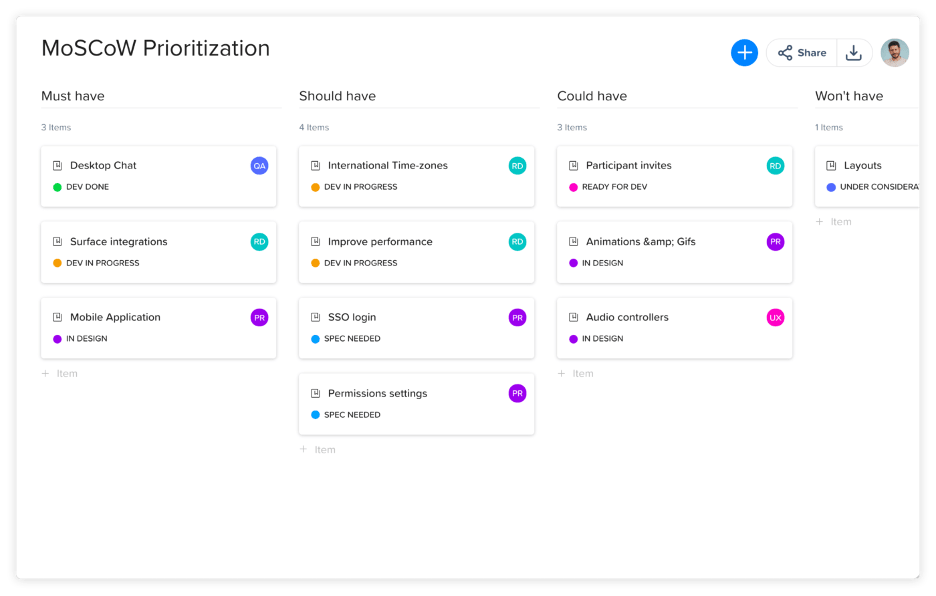What Is Product Prioritization?
One challenge every Product Manager will face often is the fact that you never have enough time or resources to pursue every feature idea on your wish list or to fulfill every stakeholder’s request for your products. No business has unlimited resources. That’s why product prioritization is one of the most valuable skills any product professional can develop.
In fact, as we state in the craft.io Product Management Prioritization Handbook, effective product management is essentially synonymous with prioritization. Fundamentally, that’s what the role is all about — identifying the most strategically advantageous work to do, based on your research and your company’s objectives, and then clearing obstacles to enable your team to do that work.
What product prioritization also includes
Product prioritization doesn’t refer only to deciding what products to create, and in what order, although that’s a key part of the process. Once they’ve decided on a solution to build, product teams will then need to prioritize many other aspects of their work, including:
- Features
(because you can’t build everything)
- User personas
(because you can’t build for everyone)
- Market segments
(because you can’t sell to everyone)
- Customer requests
(because you can’t say yes to everything)
- Strategic goals
(because you need to align your product goals with the company’s objectives)
- Success metrics
(because you can’t measure everything)
Why Is it Important to Prioritize?
Imagine the beginning of a 400-meter dash. The starter’s pistol fires, the runners take off, and one competitor clearly moves at a faster pace than anyone else. But that runner doesn’t win — in fact, he finishes last.
Why? Because he took several mistaken detours along the way. The fastest runner in the group wasted time and energy (mission-critical resources), repeatedly running in the wrong direction and course correcting each time to get back on track. In making those repeated missteps, this competitor turned what should have been a victory into the race’s worst performance.
You can build a product with lots of features, make the user interface elegant and beautiful, and test the product thoroughly to make sure everything works properly before you launch. But if you didn’t perform strategic prioritization exercises in the early stages of the product’s creation — to identify the most valuable features to include, the right user personas to target, etc. — how can you be confident that your team’s work will lead to a product that resonates with customers?
As we state in our prioritization handbook, “Success in product management will be nearly impossible without the ability to sift through a long list of ideas, opportunities, requests, etc. — and prioritize the development of those items that offer the greatest possibility of market success.”
How Product Experts Prioritize
Experienced product professionals know that the Product Manager’s gut instinct — no matter how sharp — isn’t sufficient alone for making prioritization decisions. They know they also need both data and a consistent formula to evaluate the costs and benefits of prioritizing one item over another.
That’s why smart product professionals use proven frameworks for their prioritization exercises. And fortunately, there are many proven frameworks for product prioritization that you can choose from, including:
- Weighted Scoring
- Opportunity Scoring
- Value vs. Effort
- Features by Importance
- Kano Model
- Now-Next-Later
- Classic WSJF Prioritization
- SAFe WSJF Prioritization
- MoSCoW Prioritization
- RICE Prioritization
How to select the right product prioritization framework
With so many frameworks available, how do you know which one you should use to help you decide where to invest your product team’s limited resources?
You’ll want to review each of these frameworks (and possibly others) to find the one that best suits your team’s specific needs. You might also find you have use for several frameworks at different times during your product development or as your team’s circumstances or objectives change.
To cite just one example, the classic WSJF (Weighted Shortest Job First) framework is a financially focused model that can help your team sequence your work by quantifying the cost of delaying the development of specific items.
You might find this framework useful, for example, if you need to make an economically driven case to your executive stakeholders — to show them how not moving ahead with specific work on your product could financially impact the company.
But the classic WSJF is best suited to small and midsize agile product organizations. If your company grows to enterprise size — where you have dozens or even hundreds of product department team members — you might want to switch to the Scaled Agile Framework (SAFe) version of WSJF. This is a variation of the financially focused model tailored for enterprises with large and complex product operations.
The prioritization frameworks listed above cover a wide range of approaches — from focusing on economic impact to focusing on customer delight, and from leveraging complex formulas to simply dropping competing backlog items into different buckets.
In the next section, we’ll review a few of these frameworks — what they address, when you’d want to use them, and their pros and cons.
Three Examples of Product Prioritization Frameworks
1. MoSCoW Method
MoSCoW is an acronym for the four categories into which you’ll be grouping competing items according to priority level:
- Must have
- Should have
- Could have
- Won’t have (or wish list)
Product teams often use MoSCoW prioritization when they’re in a hurry and need to quickly identify the few items (features, user stories, etc.) that they need to work on in the near-term to meet a deadline — for releasing a Minimum Viable Product (MVP), for example.

2. Kano Model
Kano is a customer-focused approach to product prioritization. In fact, that’s all it measures — the degree to which each feature will delight your customers, vs. the cost and effort to build it. Using the Kano prioritization framework, your team will categorize each backlog item into one of three groups based on how your user personas respond to your surveys (or how your own team anticipates each feature will resonate with users):
- Basics
- Performers
- Exciters
Basics represent the functionality your customers will expect from your product — clean seats in a movie theater, for example, or a battery charging cable for a smartphone.
Performers enhance the quality and user experience of your product, like the plastic stopper added to the cup of hot coffee you pick up at the drive-through window.
Exciters are the customer-delight features, the add-ons your customers aren’t asking for and that often come as a surprise to them. A few years ago, seat warmers in cars were considered an excitement feature.

3. Value vs. Effort
With the Value vs. Effort model, you’ll be measuring your competing backlog items according to two criteria: how much value they can bring to your organization and how much effort (money and time) building them will require.
This prioritization exercise will help your team discover items with greater business value and lower effort — the items you will likely want to prioritize.

Pros and cons of each product prioritization framework
Obviously, there is no single correct answer to the question, “Which product prioritization framework should I use?” Under varying circumstances, you might find uses for any of these frameworks. But here are the key strengths and weaknesses of the three we’ve just reviewed.
MoSCoW
Pro:
MoSCoW doesn’t require any formulas or complex scoring methods. Grouping items into plain-language categories like Must, Should, Could, and Won’t can make an ideal method for quick evaluation of each feature’s potential strategic value — and easy to communicate the outcome to stakeholders.
Con:
MoSCoW provides only a general, broad overview of prioritization. It doesn’t rank competing requirements or provide quantitative metrics for scoring them against each other. If your team needs a deeper analysis of competing items, you might start with MoSCoW but then move to a more quantitative framework, such as Weighted Scoring.
Kano
Pro:
Kano is a great framework if your team is laser-focused on determining the best ways to increase customer satisfaction and even delight with your products.
Con:
A common challenge with the Kano model is that even after learning which items are basics, performers, and exciters, the product team will still have difficulty analyzing the results and determining what to do about them. The answer isn’t always to pour all resources into “excitement” features — and it can be challenging to determine the right sequence of work and resource-allocation mix.
Value vs. Effort
Pro:
Value vs. Effort offers an intuitive formula for prioritization — measuring each items’ potential benefit to the company against its cost to build. That makes it a useful methodology for presenting a data-backed case to executives, investors, or other decision-making stakeholders.
Con:
Many teams find this approach too subjective in terms of scoring an item’s potential value. That can lead to debates among team members and stakeholders and undermine the team’s ability to agree on priorities.
Bonus Tip: Get Access to All of These Prioritization Frameworks
The easiest way to give your team access to whichever prioritization methodology you need —and to switch among them as often as you want — is with a product management platform that has many proven prioritization frameworks built-in. The great news? You can pour your product content into the craft.io platform with a few clicks and start prioritizing your backlog items right after that.

Try craft.io for free































